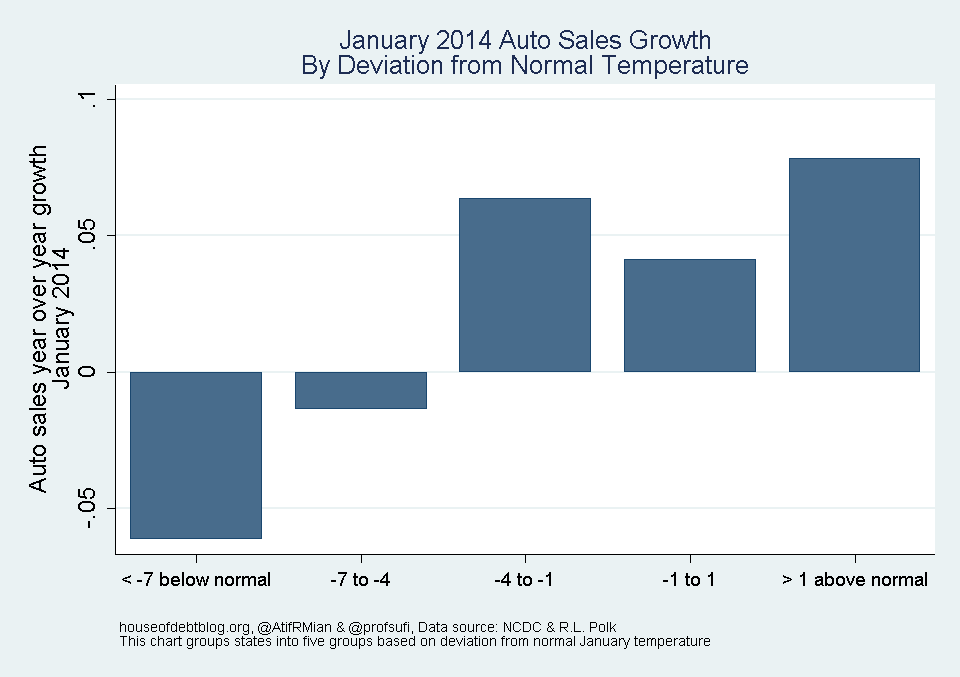Retail spending by households in January 2014 was a major disappointment, coming in well below expectations. January 2014 was also one of the coldest months in memory in many parts of the country. Was the extreme cold weather to blame for weak retail spending? Or is the economy weakening? Perhaps households were trying to save more, due to a pessimistic economic outlook?These questions are especially pressing given the release of data tomorrow on February 2014 retail spending–February again was a very cold month.
We use state-level data on new auto purchases to attack this question. Here is the basic idea. Not all states experienced a horrible January 2014 — in fact, much of the western part of the country actually was warmer than normal. We can use this variation across the country in January weather to see if national auto sales were brought down by states that experienced abnormally cold temperatures.
First, let’s split up states into five categories based on how far below their normal January temperature they were in January 2014. And then let’s look at the average growth in year-over-year new auto purchases in each of the groups. Here is the chart:
The evidence is pretty clear. New auto purchases in January 2014 were more than 5% down in states that were more than 7 degrees below their normal January temperature. New auto purchases were down slightly in states that were between -7 and -4 degrees below normal. In the rest of the country where temperatures were closer to normal, new auto purchases were quite strong.
New auto purchases were definitely brought down by cold weather. But by how much? One way to answer this is to just take out the very coldest states and recalculate the aggregate growth in new auto purchases. This is what we do in the chart below.
The growth in new auto purchases in January 2014 was about 0.7%. If we take out the 11 states with extremely cold temperatures (7 degrees below normal or more), new auto purchases grew by more than 2%. A substantial part of weak auto spending in January 2014 can be attributed to these very cold states.
So what does it mean? The evidence suggests caution in reading too much into weak retail spending in January. It was probably due more to bad weather than to a weakening economy. When it comes to durable goods such as cars, it is likely that purchases will increase sharply when the weather improves in the states that had extremely cold winters.
While we focus in this post on the weather and auto purchases, we hope it shows the power of using micro-economic data to answer macro-economic questions. The use of individual-, zip-, county-, and state-level data has been a hallmark of our research, and is featured prominently in our book.
Here are some more details of our calculations. We excluded three states: Alaska, Hawaii, and Utah. The NCDC does not have historical data for the first two states, and we had some data issues with Utah–we will include Utah when we get the data issue resolved. The auto purchase measure is just the number of cars bought; we do not have the prices of the cars.
We noticed that the Census retail sales January 2014 release has much stronger year over year growth in auto sales than is present in our data. Our data is based on new vehicle registrations, whereas the Census data is based on a random sample of businesses. It could be that some vehicle registrations in our data come in slowly — we will revise these figures when we receive updates. Or it could be that the Census advanced report overstates January 2014 auto sales, which we will know when the February 2014 data are released tomorrow. Regardless, it is doubtful that the differences across states we detail here are due to measurement issues.
Below is the full scatter-plot showing every state and the regression line relating 2014 auto purchase growth to the deviation from normal January temperature in a state.








